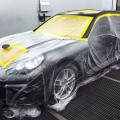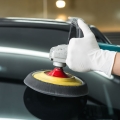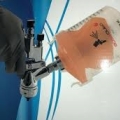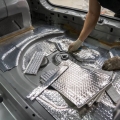Bodyshop materials
Preparing your car for paint is a crucial step to ensure a smooth, professional finish. Here’s a comprehensive guide on how to prep your car for painting:
Step 1: Gather Necessary Tools and Materials
- Sandpaper: Various grits (80, 180, 320, 400, and 600)
- Sanding block or power sander
- Masking tape and paper
- Plastic sheeting
- Primer
- Body filler (Bondo)
- Cleaner or degreaser
- Tack cloth
- Protective gear: Gloves, goggles, mask
- Paint sprayer or aerosol cans
Step 2: Clean the Car
- Wash thoroughly: Use soap and water to remove dirt, grime, and grease.
- Degrease: Use a cleaner or degreaser to ensure the surface is free from oils and contaminants.
Step 3: Remove or Mask Parts
- Remove trim and accessories: Take off mirrors, badges, and other removable parts to avoid painting over them.
- Masking: Use masking tape and paper to cover areas that you don't want to paint, such as windows, tires, and headlights.
Step 4: Sand the Surface
- Initial Sanding: Start with a coarse grit (80 or 180) to remove the old paint and any surface imperfections.
- Smooth Sanding: Use finer grits (320, 400) to smooth out the surface.
- Final Sanding: Finish with very fine grit (600) for a smooth surface ready for primer.
Step 5: Repair Surface Imperfections
- Apply Body Filler: Use body filler to repair dents and scratches. Apply, let it dry, and then sand it smooth with a fine grit sandpaper.
- Feather Edges: Ensure edges of the filled areas blend seamlessly with the rest of the car surface.
Step 6: Clean the Surface Again
- Remove Dust: Use a tack cloth to wipe away dust from sanding.
- Degrease: Clean the surface again to ensure it is free from any oils or contaminants.
Step 7: Apply Primer
- Choose the Right Primer: Use a primer suitable for your car’s surface.
- Spray Evenly: Apply in thin, even coats. Follow the manufacturer’s instructions for drying times between coats.
- Sand the Primer: Once dry, sand the primer with 600 grit sandpaper to smooth it out.
Step 8: Final Cleaning
- Clean with Tack Cloth: Use a tack cloth to remove any dust particles after sanding the primer.
- Ensure Surface is Clean: Double-check for any remaining dust or contaminants.
Tips for Success
- Work in a Clean Environment: A clean, dust-free workspace is crucial.
- Proper Ventilation: Ensure your workspace is well-ventilated.
- Patience: Take your time with each step to ensure the best results.
By following these steps carefully, you can achieve a professional-quality paint job on your car.







